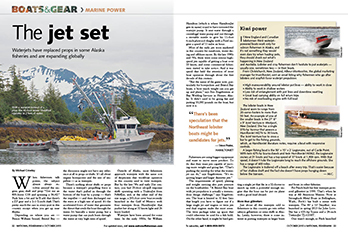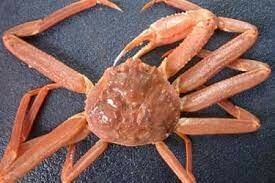The jet set
Waterjets have replaced props in some Alaska fisheries and are expanding globally
By Michael Crowley
When fishermen talk power, the subject almost always revolves around the engine, gear, shaft and prop: “Got me an 800-horse C18 and spinning a 36-42.” Push him a bit and he’ll add that there’s a ZF gear and a 2-1/2-inch shaft. That’s pretty much the case in every port in this country except when you get up near Alaska.
Depending on where you are — Prince William Sound, Bristol Bay — the discussion might not have any reference at all to props or shafts. It’s all about engine horsepower and the size of impellers — as in waterjets.
There’s nothing about shafts or props because a waterjet’s propelling force is the water that’s pulled in through the bottom of the boat by a pump — that’s the impeller — and then discharged out the stern at a high rate of speed. It’s the accelerated force of water that generates the thrust that sends the boat through the water. It’s basically a water pump, but a water pump that can push boats through the water at very high rates of speed.
Outside of Alaska, most fishermen approach waterjets with the same sort of skepticism that workboat operators in this country used to view waterjets. But by the late ’90s and early 21st century, you had 20-foot oil-spill response skiffs operating with a TraktorJet from NAMJet, and, at the other end of the size range, a 205-foot crew boat recently launched in the Gulf of Mexico with four waterjets from HamiltonJet that pushes her along at 32 knots light and 26 knots loaded.
Waterjets have been around for some time. In the early 1950s, Sir William Hamilton (which is where HamiltonJet gets its name) is said to have invented the waterjet pump. It sent water through a centrifugal water pump and out through a steerable nozzle to give his 11-foot 6-inch plywood dinghy with a Ford engine a speed of 11 miles an hour.
Most of the early jets were marketed in this country for runabouts, water skiing and offshore racers. By the late 1980s and ’90s, there were some serious high-speed jets capable of getting a boat over 50 knots, and some commercial fishermen started to take notice. And it was speed that held the attention of most boat operators through about the first decade of this century.
“But the name of the game now, particularly for bowpickers and Bristol Bay boats, is how much weight can you get up and plane,” says Eric Engebretsen at Bay Welding Services in Homer, Alaska. It didn’t used to be going fast and putting 10,000 pounds on the boat, but now it is.
Fishermen are using bigger equipment and want to move more product. To do that they want jets capable of moving more weight and going fast. “That’s pushing the envelop for what the waterjet can do,” says Engebretsen. “It’s requiring larger and larger diameter jets.”
The requirements of speed, planing and weight carrying also puts pressure on the boatbuilder. “A Bristol Bay boat with jet propulsion is actually a tremendous design challenge,” says Engebretsen. The boat is limited to 32 feet. Into that length you have to figure out if a large single jet and engine or twin jets and dual engines make the most sense. The twin package takes up space that could otherwise be used for a fish hold. On the other hand, it might be hard getting a single jet that fits in a 32-footer to match up with a powerful enough engine that… » Read the full article in our October issue.








